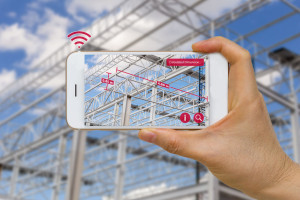 When you visit a construction site in 2019, don’t be surprised to see the civil engineering professionals wearing a range of technologies on their wrists, arms, even built into their glasses. You’ll see more construction supervisors and workers using and wearing digital devices, using them to communicate and to check instructions and plans. And as they do, they’ll be putting more digital technology into the buildings and infrastructure.
When you visit a construction site in 2019, don’t be surprised to see the civil engineering professionals wearing a range of technologies on their wrists, arms, even built into their glasses. You’ll see more construction supervisors and workers using and wearing digital devices, using them to communicate and to check instructions and plans. And as they do, they’ll be putting more digital technology into the buildings and infrastructure.
It’s the major civil engineering trend for the times: the acceleration of digital technology into everything we make and build, as well as into the way we make them.
Technology in the civil engineering office
New construction and updates and upgrades to infrastructure will add more digital technology, enabling the so-called “smart city.”
Building information modeling, or BIM, will continue to grow in civil engineering and other applications. BIM is technology that provides three-dimensional representations of buildings, infrastructure and other construction projects. It also adds in richer information, including materials, schedules, and cost, in what’s called “5D BIM.” BIM enables better conceptualization and visualization of a project, better planning, conflict resolution, quality and cost control, as well as more complete monitoring of a project.
The construction software and data ecosystem is a civil engineering concept where all the parties involved in planning and construction collaborate in common sets of digital files. Integrating the many different processes and systems into a single, fully connected platform can be a huge challenge, but when it’s accomplished, it can empower all the players to achieve much more. At minimum, the integrated data ecosystem can minimize delays, resolve conflicts, reduce rework and empower communication among construction, engineering office and owner.
Cloud and mobile technology are already being used in civil engineering offices and at construction sites because they allow the team to leverage their investment in IT and data wherever they are, whenever they need them. Expect to see it being extended in new ways for more processes, using innovative new devices.
On the construction site
Owners and developers have always had to rely on imagination to visualize a new building before it’s built. Imagine now being able to see exactly what it will look like, in place, before the first shovel breaks ground.
That’s the promise of augmented reality (AR). Like many technologies now considered essential in commercial and industrial applications, augmented reality has had its growth spurred by gaming and entertainment. Devices and even headsets or visors show a digital image integrated with the real world. It thus provides a full, three-dimensional representation of a completed construction project, allowing owners, developers, architects and civil engineering professionals to see how their plans will fit into the existing environment. It’s another tool to anticipate and resolve construction conflicts and improve planning.
Civil engineering is beginning to make more use of wearable technology, for a range of uses: monitoring, accessing remote digital resources, and for communicating with managers, supervisors and workers.
GPS (global positioning system) tracking is already being used extensively in construction and civil engineering, and we can expect to see more creative uses of this technology. It reduces the time required for surveying, speeds the collection of accurate site data and helps project managers in dispatching and managing fleets of vehicles. Site managers are even using GPS to help find lost or stolen equipment.
Drones are finding more applications on the construction site. They allow surveyors to survey a site in minutes, and bring new possibilities in monitoring, inspection and civil engineering.
Some experts are predicting that robots will soon be able to lay bricks and tie rebar. We can expect to see robotics taking on more and more human tasks on the construction site.
Civil engineering has always led the way in innovative applications of every kind of technology. Expect to see more innovative uses of new technology in ways no one imagined before.








